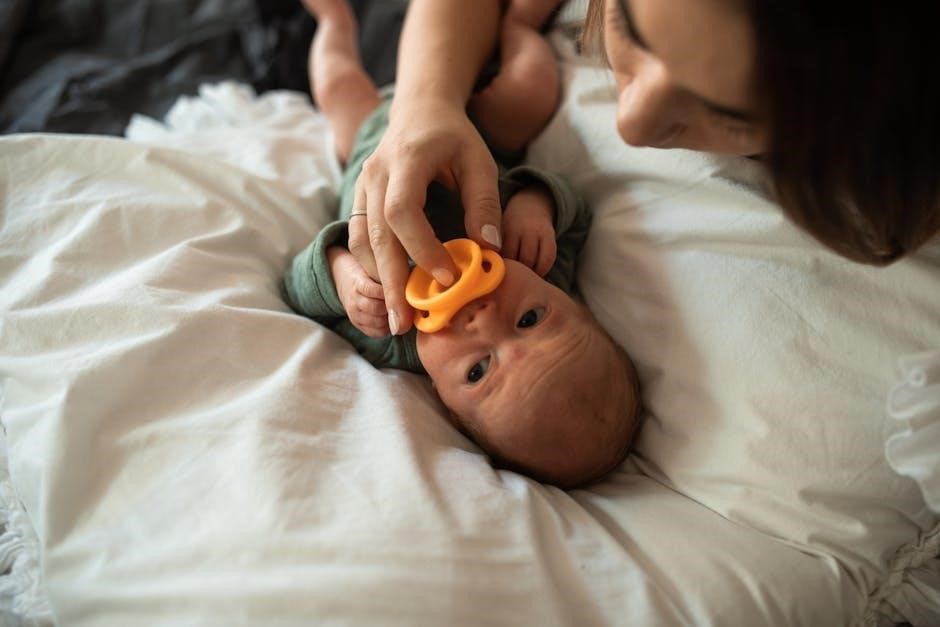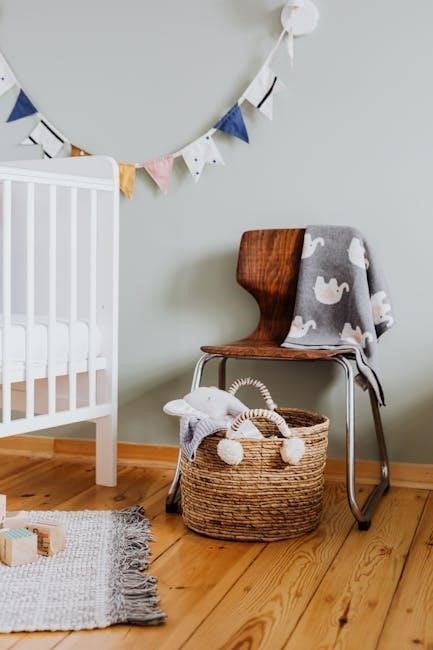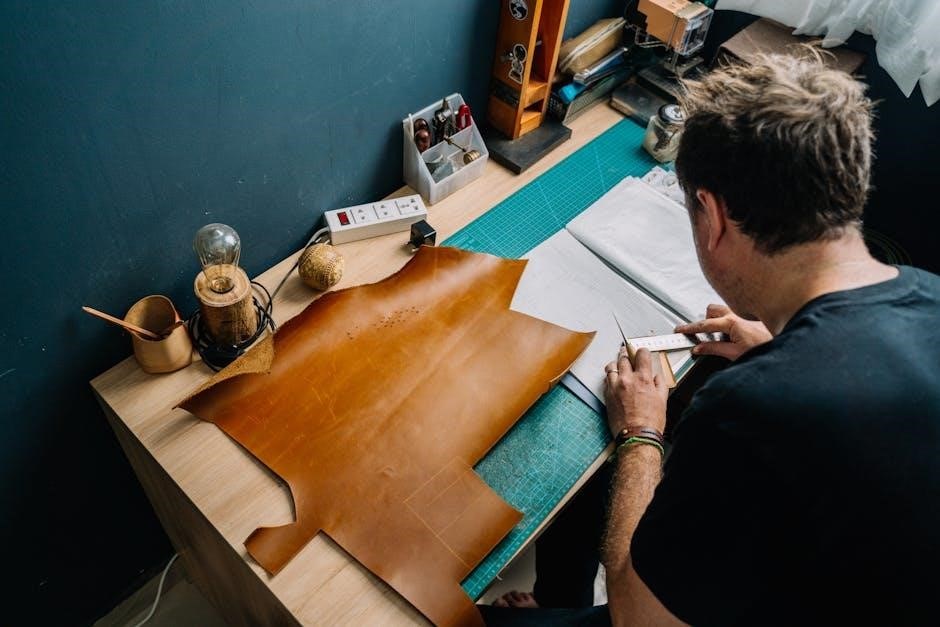The 4-in-1 crib offers versatility, adapting from a crib to a toddler bed, daybed, and beyond. This guide provides clear instructions for assembly, conversion, and maintenance.
Follow these steps to ensure safety, proper assembly, and optimal use of your crib. Always prioritize careful planning and adherence to the provided instructions.
1.1 Overview of 4-in-1 Crib Features
A 4-in-1 crib is a versatile and practical solution for growing families, offering four distinct configurations: baby crib, toddler bed, daybed, and full-size bed. Designed for longevity, it adapts to your child’s needs, from infancy through adolescence. These cribs often feature adjustable height settings, ensuring comfort and safety at every stage. Many models include storage options, such as drawers or shelves, to keep essentials within reach. Durable materials and sleek designs make them a stylish addition to any nursery. The multi-functional design minimizes the need for frequent furniture updates, providing value and convenience for years to come.
1.2 Importance of Following Assembly Instructions
Following the assembly instructions for your 4-in-1 crib is crucial for ensuring safety, stability, and proper functionality. Misassembly can lead to structural weaknesses, posing risks to your child. The instructions provide step-by-step guidance to guarantee a secure and correct setup. Ignoring or deviating from these steps may result in safety hazards, such as loose parts or uneven surfaces. Always read the manual thoroughly before starting and double-check each step. Proper assembly ensures compliance with safety standards, protecting your child from potential harm. Failure to follow instructions may also void the product warranty, so attention to detail is essential for long-term reliability and performance.

Safety Precautions and Warnings
Always follow safety guidelines to prevent injuries and ensure stability. Never ignore warnings, as improper assembly can lead to serious harm or crib instability.
2.1 General Safety Guidelines
Adhere strictly to all safety guidelines to ensure your child’s well-being. Always read the entire manual before starting assembly to avoid mistakes. Use only the provided hardware and tools to prevent structural issues. Keep small parts out of your child’s reach to avoid choking hazards. Never leave the crib unattended during assembly. Ensure the crib is placed on a firm, level surface. Avoid adding extra padding or pillows, as they can pose suffocation risks. Regularly inspect the crib for loose joints or worn parts and tighten them immediately. This will help maintain stability and prevent potential accidents. Always follow the manufacturer’s recommendations for weight limits and usage guidelines to ensure safety and longevity of the crib. By adhering to these guidelines, you can create a secure environment for your child to sleep and grow.
2.2 Warning Against Improper Assembly
Improper assembly of the crib can result in serious injury or death. Always follow the provided instructions precisely to ensure the crib’s stability and safety. Failure to adhere to the guidelines may lead to structural weaknesses, posing risks to your child. Never use substitute parts or modify the crib in any way, as this can compromise its integrity. Loose fasteners or incorrect assembly can trap body parts or clothing, leading to potential harm. Strictly avoid adding extra padding or pillows, as they increase suffocation risks. Proper assembly is crucial for your child’s safety and well-being.

Tools and Materials Required
Assembly requires a Phillips head screwdriver, Allen wrench, and all provided hardware. Ensure all parts are included before starting. Organize tools and materials for efficiency.
3.1 List of Tools Needed (e.g., Screwdrivers, Allen Wrench)
The assembly process requires specific tools to ensure proper construction. A Phillips head screwdriver is essential for driving screws, while an Allen wrench is needed for securing bolts. Additionally, you may need a socket wrench or adjustable wrench for certain hardware. Some cribs also require a small hammer for tapping parts into place. Ensure all tools are readily available before starting. It’s important to verify that all hardware and parts are included in the package to avoid delays. Always refer to the manufacturer’s list for specific tool requirements to guarantee a smooth assembly process.
3.2 Description of Hardware and Parts
The crib includes various hardware components, such as bolts, screws, and cam locks, designed for secure assembly. The Allen wrench is typically provided for tightening bolts. Additionally, expansion bolts and hex keys may be included for specific connections. The crib itself consists of a headboard, footboard, and side panels, all constructed from durable materials. The mattress support is usually adjustable, ensuring proper height settings. Always organize and count all parts before assembly to ensure nothing is missing. Follow the manufacturer’s instructions for identifying and using each component correctly to guarantee stability and safety. Proper hardware usage is critical for the crib’s structural integrity.

Unpacking and Preparation
Begin by carefully unpacking all components and laying them on a soft, scratch-free surface. Ensure no parts are missing and keep instructions handy for reference. Adult assembly required due to small components.
4.1 Steps to Unpack the Crib
Begin by carefully opening the packaging and removing all components. Lay out the parts on a soft, scratch-free surface to prevent damage. Remove all plastic wrapping and protective coverings. Check for completeness by cross-referencing with the parts list in the instructions. Ensure no items are missing or damaged. Organize hardware separately for easy access during assembly. Keep the instruction manual nearby for reference. Adult assembly is required, and small parts may be present, so keep them out of reach of children until assembly is complete. Proper organization ensures a smooth and efficient assembly process.
4.2 Organizing Parts and Hardware
After unpacking, separate the hardware from the main crib components. Use containers or ziplock bags to store screws, bolts, and small parts. Label each bag for easy identification. Place larger parts like side frames and the headboard in a designated area. Cross-reference the parts list in the instruction manual to ensure no items are missing or damaged. This step ensures a systematic approach to assembly, reducing the risk of lost or misplaced components. Proper organization saves time and minimizes frustration during the assembly process.

Assembly Instructions
Begin by assembling the headboard, then attach side frames using the provided hardware. Secure the footboard and mattress support tightly. Follow each step carefully for stability.
5.1 Assembling the Headboard
Begin by unpacking and identifying all headboard components. Use a Phillips head screwdriver to attach side panels to the main headboard frame. Ensure all screws are securely tightened but not overtightened. Align the headboard’s decorative trim or supports according to the manufacturer’s diagrams. Double-check that all bolts and screws are properly fitted to avoid instability. Sand any sharp edges for safety. Follow the manual step-by-step to ensure a sturdy and level assembly, essential for the crib’s stability and your baby’s safety.
5.2 Attaching Side Frames
Align the side frames with the headboard and footboard, ensuring proper fitment. Use the Allen wrench to secure the frames using the provided bolts. Insert bolts into pre-drilled holes, tightening until snug but not overly tight. Double-check alignment using a carpenter’s square for stability. Once both sides are attached, test the crib’s sturdiness by gently rocking it. Ensure all connections are secure to prevent wobbling. Proper alignment and tightness are crucial for safety and durability. Follow the manufacturer’s diagrams for correct bolt placement and torque specifications.
5.3 Connecting the Footboard
Align the footboard with the side frames, ensuring it fits snugly into the designated slots. Use the Allen wrench to secure it with the provided bolts, tightening firmly but avoiding overtightening. Double-check the alignment using the manufacturer’s diagram for accuracy. Once attached, gently rock the crib to ensure stability and even weight distribution. Make sure all bolts are tightly fastened to prevent any wobbling or movement. Proper connection of the footboard is essential for the crib’s structural integrity and safety; Follow the assembly guide carefully to avoid misalignment or loose connections.
5.4 Securing the Mattress Support
Locate the mattress support platform and align its brackets with the crib’s side frame hooks. Attach the support using the provided screws, ensuring they are tightened securely with a screwdriver. Adjust the height settings according to the desired position, making sure it clicks firmly into place. Double-check the support’s stability by gently pressing down. Properly securing the mattress support ensures a safe and even surface for the mattress, preventing sagging or movement. Always refer to the manufacturer’s guidelines for specific height adjustments and safety recommendations.

Converting the Crib
Transform your crib into a toddler bed, daybed, or other configurations by following specific conversion steps. Ensure all hardware is securely adjusted for each stage. Always follow the manufacturer’s instructions for a safe and proper transition.
6.1 Converting to a Toddler Bed
Begin by removing the front rail and lowering the mattress support to the toddler bed position. Attach the toddler bed conversion kit, ensuring all bolts are tightly secured. Follow the manufacturer’s instructions precisely to avoid stability issues. Double-check that the bed is level and sturdy. For safety, ensure no loose parts are present and avoid adding extra padding or pillows. Transitioning to a toddler bed is a significant milestone, so careful assembly is crucial for your child’s safety and comfort. Always refer to the provided instructions for specific details on converting your 4-in-1 crib to a toddler bed.
6.2 Transitioning to a Daybed
To convert the crib to a daybed, remove the toddler bed conversion kit and attach the daybed frame according to the manufacturer’s instructions. Ensure all bolts and screws are securely tightened for stability. The daybed mode is ideal for older children, offering a comfortable and stylish sleeping solution. Always double-check the frame’s alignment and stability before use; For added comfort, you can place a standard twin mattress, but avoid using crib mattresses. Ensure the bed is level and free from any loose parts for optimal safety and durability. Transitioning to a daybed is a seamless process with proper assembly and care.
6.3 Adjusting the Height Settings
Adjusting the height settings on your 4-in-1 crib ensures it adapts to your child’s growth. Use the provided Allen wrench or screwdriver to lower or raise the mattress support. Start with the highest setting for newborns and gradually lower it as your child grows. Ensure the mattress support is securely locked after each adjustment. Always check the crib’s stability and alignment after changing the height. Avoid over-tightening, as this may damage the mechanism. Proper height adjustment prevents the child from climbing out and ensures safe sleep. Refer to the manual for specific height positions and adjustment limits. Safety is paramount at every stage. Maintain stability for optimal use. Regularly inspect the height settings for any looseness. This feature enhances the crib’s versatility, catering to different growth phases. Adjustments should only be made by an adult to ensure accuracy and safety. Keep the crib stable and level after each adjustment. Proper height settings are crucial for preventing accidents and ensuring comfort. Always follow the manufacturer’s guidelines for height adjustments. This ensures the crib remains safe and functional for years. Adjusting the height settings is a straightforward process when done correctly. Ensure all bolts are tightened securely after adjustments. This feature is designed to provide long-term convenience and safety. Always verify the crib’s stability after making changes. Adjusting the height settings is a key part of maintaining your child’s safety and comfort. Follow the instructions carefully to avoid any issues. The height settings are a valuable feature, offering flexibility as your child grows. Regular checks are essential to ensure the crib remains stable and secure. Adjusting the height settings is a simple yet important task for your child’s safety. Always prioritize stability and proper alignment. This ensures the crib remains a safe and comfortable space for your child. Adjusting the height settings is a crucial step in maintaining the crib’s functionality and safety. Follow the instructions precisely to ensure optimal results. This feature is designed to adapt to your child’s needs, providing years of reliable use. Always double-check the height settings after adjustments. Proper alignment and stability are essential for safety. Adjusting the height settings is a key part of maintaining your 4-in-1 crib. Follow the manufacturer’s guidelines to ensure everything is done correctly. This ensures the crib remains safe and functional for your child. Adjusting the height settings is a simple process that requires attention to detail. Always ensure the crib is stable and secure after adjustments. This feature is designed to provide long-term convenience and safety. Regular checks are necessary to maintain the crib’s integrity. Adjusting the height settings is a vital part of caring for your 4-in-1 crib. Always follow the instructions carefully to ensure safety and functionality. This ensures the crib remains a reliable and comfortable space for your child. Adjusting the height settings is a straightforward task when done correctly. Always prioritize stability and proper alignment. This ensures the crib remains safe and functional for years to come. Adjusting the height settings is a key feature of the 4-in-1 crib, offering flexibility and convenience. Always follow the manufacturer’s instructions to ensure safety and optimal performance. This feature is designed to adapt to your child’s growth, providing a safe and comfortable sleeping environment. Adjusting the height settings is a simple yet important task. Always ensure the crib is stable and secure after adjustments. This ensures the crib remains a safe and reliable space for your child. Adjusting the height settings is a crucial step in maintaining the crib’s functionality and safety. Follow the instructions precisely to ensure optimal results. This feature is designed to provide long-term convenience and safety. Always double-check the height settings after adjustments. Proper alignment and stability are essential for safety. Adjusting the height settings is a key part of maintaining your 4-in-1 crib. Follow the manufacturer’s guidelines to ensure everything is done correctly. This ensures the crib remains safe and functional for your child. Adjusting the height settings is a simple process that requires attention to detail. Always ensure the crib is stable and secure after adjustments. This feature is designed to provide long-term convenience and safety. Regular checks are necessary to maintain the crib’s integrity. Adjusting the height settings is a vital part of caring for your 4-in-1 crib. Always follow the instructions carefully to ensure safety and functionality. This ensures the crib remains a reliable and comfortable space for your child. Adjusting the height settings is a straightforward task when done correctly. Always prioritize stability and proper alignment. This ensures the crib remains safe and functional for years to come. Adjusting the height settings is a key feature of the 4-in-1 crib, offering flexibility and convenience. Always follow the manufacturer’s instructions to ensure safety and optimal performance. This feature is designed to adapt to your child’s growth, providing a safe and comfortable sleeping environment. Adjusting the height settings is a simple yet important task. Always ensure the crib is stable and secure after adjustments. This ensures the crib remains a safe and reliable space for your child. Adjusting the height settings is a crucial step in maintaining the crib’s functionality and safety. Follow the instructions precisely to ensure optimal results. This feature is designed to provide long-term convenience and safety. Always double-check the height settings after adjustments. Proper alignment and stability are essential for safety. Adjusting the height settings is a key part of maintaining your 4-in-1 crib. Follow the manufacturer’s guidelines to ensure everything is done correctly. This ensures the crib remains safe and functional for your child. Adjusting the height settings is a simple process that requires attention to detail. Always ensure the crib is stable and secure after adjustments. This feature is designed to provide long-term convenience and safety. Regular checks are necessary to maintain the crib’s integrity. Adjusting the height settings is a vital part of caring for your 4-in-1 crib. Always follow the instructions carefully to ensure safety and functionality. This ensures the crib remains a reliable and comfortable space for your child. Adjusting the height settings is a straightforward task when done correctly. Always prioritize stability and proper alignment. This ensures the crib remains safe and functional for years to come. Adjusting the height settings is a key feature of the 4-in-1 crib, offering flexibility and convenience. Always follow the manufacturer’s instructions to ensure safety and optimal performance. This feature is designed to adapt to your child’s growth, providing a safe and comfortable sleeping environment. Adjusting the height settings is a simple yet important task. Always ensure the crib is stable and secure after adjustments. This ensures the crib remains a safe and reliable space for your child. Adjusting the height settings is a crucial step in maintaining the crib’s functionality and safety. Follow the instructions precisely to ensure optimal results. This feature is designed to provide long-term convenience and safety. Always double-check the height settings after adjustments. Proper alignment and stability are essential for safety. Adjusting the height settings is a key part of maintaining your 4-in-1 crib. Follow the manufacturer’s guidelines to ensure everything is done correctly. This ensures the crib remains safe and functional for your child. Adjusting the height settings is a simple process that requires attention to detail. Always ensure the crib is stable and secure after adjustments. This feature is designed to provide long-term convenience and safety. Regular checks are necessary to maintain the crib’s integrity. Adjusting the height settings is a vital part of caring for your 4-in-1 crib. Always follow the instructions carefully to ensure safety and functionality. This ensures the crib remains a reliable and comfortable space for your child. Adjusting the height settings is a straightforward task when done correctly. Always prioritize stability and proper alignment. This ensures the crib remains safe and functional for years to come. Adjusting the height settings is a key feature of the 4-in-1 crib, offering flexibility and convenience. Always follow the manufacturer’s instructions to ensure safety and optimal performance. This feature is designed to adapt to your child’s growth, providing a safe and comfortable sleeping environment. Adjusting

Disassembly and Storage
Disassemble the crib by reversing assembly steps. Remove all hardware and store in labeled bags. Clean and protect the crib from dust and damage during storage.
7.1 Steps to Disassemble the Crib
Begin by removing bedding and mattresses. Use a screwdriver to remove screws or bolts from the side frames and headboard. Gently lift and detach the side rails.
Next, remove the mattress support by taking out the supporting brackets. Carefully disassemble the footboard and any additional components. Place all hardware in labeled bags for safekeeping.
Once the crib is fully disassembled, clean each part with a soft cloth. Store components in a dry, secure location to prevent damage or loss. Always follow manufacturer guidelines for disassembly.
7.2 Proper Storage Techniques
Store disassembled crib parts in a cool, dry place. Use protective covers or bags to prevent dust and moisture damage. Label each bag for easy identification later.
Avoid stacking heavy items on the crib components. Keep all hardware in separate, labeled containers to ensure nothing gets lost or misplaced. Store instructions with the crib parts for future reference.
Ensure the storage area is secure and out of children’s reach. This will help maintain the crib’s condition and ensure it remains safe for future use.

Maintenance and Care
Regularly clean the crib with a damp cloth, avoiding harsh chemicals. Inspect for loose parts and tighten as needed to ensure stability and safety.
Refer to the manufacturer’s guidelines for specific care instructions, especially for finishes or fabrics. Proper maintenance ensures longevity and safety for your child.
8.1 Cleaning the Crib
Regular cleaning is essential for maintaining a safe and hygienic environment. Use a soft, damp cloth to wipe down all surfaces, avoiding harsh chemicals or abrasive cleaners.
For tougher stains, mix a mild soap with warm water, but ensure the crib is thoroughly rinsed and dried to prevent moisture buildup.
Inspect for loose parts during cleaning and tighten as needed. Avoid using bleach or aerosol products, as they may damage finishes or harm your child.
Always refer to the manufacturer’s guidelines for specific cleaning instructions, especially for fabric components or stained finishes.
Keeping the crib clean and well-maintained ensures longevity and safety for your child.
8.2 Inspecting for Loose Parts
Regularly inspect the crib for loose screws, bolts, or joints to ensure stability and safety. Check all hardware, including mattress support brackets and frame connections.
Use a screwdriver or Allen wrench to tighten any loose parts immediately. Pay special attention to areas subject to frequent movement, such as the headboard and side frames.
Inspect for worn or damaged components and replace them if necessary. Loose parts can pose a hazard, so thorough checks are essential to maintain your child’s safety.
Make this inspection a routine part of crib maintenance to prevent potential risks and ensure the crib remains sturdy for years to come.

Troubleshooting Common Issues
Common issues include loose parts, wobbling, or difficulties during conversion. Tighten all hardware and ensure proper alignment. Consult the manual or manufacturer support for unresolved problems.
Address instability by checking for missed connections or uneven surfaces. Reassemble any misaligned parts and verify all screws are securely tightened to maintain crib stability.
For conversion issues, ensure all bolts and brackets are correctly positioned. Follow instructions carefully to avoid errors during transitions between crib configurations.
9.1 Resolving Assembly Problems
If you encounter issues during assembly, start by verifying all parts are included and correctly identified. Double-check the instructions for each step to ensure accuracy. Loose connections or misaligned pieces can often be fixed by tightening screws or realigning components. If hardware seems missing or damaged, contact the manufacturer. For stuck or overly tight parts, gently apply force without damaging the material. Avoid using excessive force, as this may harm the crib’s structure. Consulting online assembly videos or manufacturer support can also provide clarity and solutions for specific challenges during the assembly process.
9.2 Addressing Stability Concerns
Ensure the crib is stable by verifying all connections are tight and secure. Loose bolts or uneven surfaces can compromise stability. Check for any missing or misaligned hardware and correct immediately. Regularly inspect the mattress support and frame for signs of wear or damage. If the crib wobbles, adjust the legs or ensure the floor is level. Always follow the manufacturer’s guidelines for weight limits and proper assembly. For persistent instability, consult the instruction manual or contact customer support for assistance. Stability is crucial for your child’s safety, so address any concerns promptly and thoroughly.

Additional Resources and Support
Access manufacturer manuals and assembly videos on official websites. Visit forums for additional guidance. Contact customer support for further assistance.
10.1 Accessing Manufacturer Manuals
Manufacturer manuals are essential for understanding the assembly, safety, and maintenance of your 4-in-1 crib. These manuals are typically included in the product packaging or available for download on the manufacturer’s official website. Ensure you read the manual thoroughly before starting the assembly process. It contains critical information, such as safety guidelines, assembly steps, and troubleshooting tips. For cribs like the DaVinci Kalani or Delta Children Baker, manuals are often accessible online in PDF format. If you cannot find the manual, contact customer support for assistance. Always keep a digital or printed copy for future reference.
10.2 Finding Assembly Videos Online
To supplement written instructions, manufacturers often provide assembly videos for 4-in-1 cribs. These videos are typically available on platforms like YouTube or the manufacturer’s official website. For models like the DaVinci Kalani or Simmons Kids Paloma, specific assembly videos are designed to guide users through each step visually. When searching, ensure the video matches your crib’s exact model number to avoid confusion. Additionally, some brands, like Delta Children, offer dedicated assembly videos for their products. Watching these can clarify complex steps and ensure proper assembly. If unsure, contact customer support for direct links to the correct resources.



